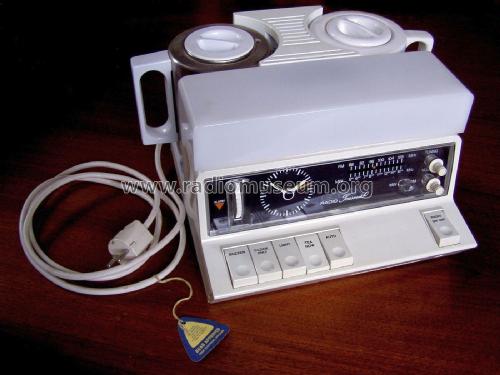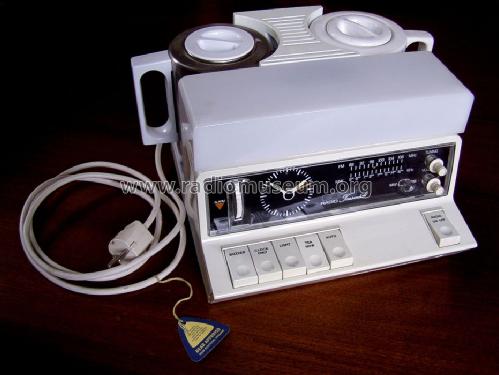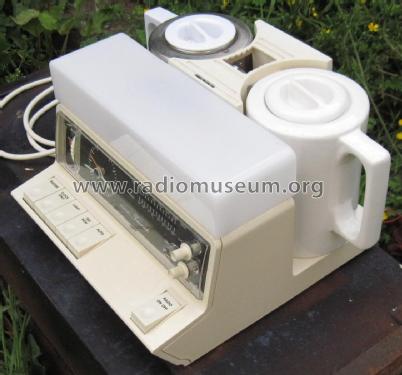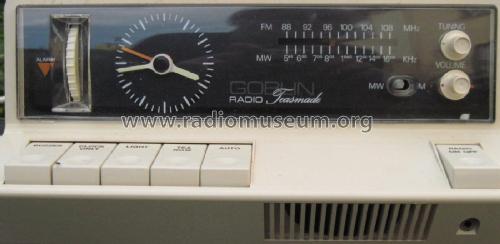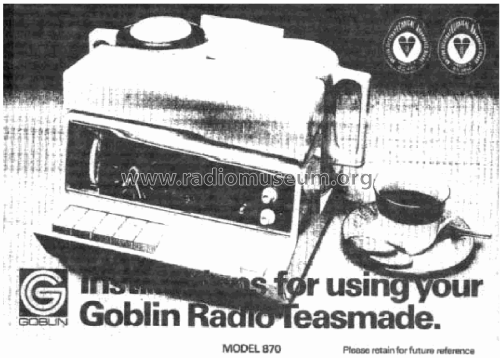Goblin Teasmade 870
British Vacuum Cleaner, Leatherhead
- Country
- Great Britain (UK)
- Manufacturer / Brand
- British Vacuum Cleaner, Leatherhead
- Year
- 1979
- Category
- Broadcast Receiver - or past WW2 Tuner
- Radiomuseum.org ID
- 218495
-
- Brand: Goblin
- Number of Transistors
- 2
- Semiconductors
- TDA1220
- Main principle
- Superheterodyne (common)
- Wave bands
- Broadcast (BC) and FM or UHF.
- Details
- Radio with other functions
- Power type and voltage
- Alternating Current supply (AC) / 220-240 Volt
- Loudspeaker
- Permanent Magnet Dynamic (PDyn) Loudspeaker (moving coil) / Ø 3.5 inch = 8.9 cm
- Material
- Various materials
- from Radiomuseum.org
- Model: Goblin Teasmade 870 - British Vacuum Cleaner,
- Shape
- Tablemodel, with any shape - general.
- Dimensions (WHD)
- 290 x 280 x 200 mm / 11.4 x 11 x 7.9 inch
- Notes
-
British clock radio with tea making:
First Goblin teasmade with a built-in radio. Wakes up at the set time with radio, light and prepares fresh tea! All previous models awoke only with a buzzer.
It's been alleged that Grundig supplied the radio, but the PCB has Capetronic, a radio and OEM in Hong Kong acquired by BSR during the production. Socket for earphone.Radio has 2 x transistors, 2 ICs
Made in UK by Goblin (BVC) Ltd.
(Britischer Radiowecker mit Teebereitung:
Weckt zum eingestellten Zeitpunkt mit Radio, Licht und bereitet dabei frischen Tee!
Das Modell 870 ist das Spitzenmodell der Goblin-Teasmade Serie. Alle Vorgängermodelle weckten nur mit einem Summton.)
- Source of data
- - - Manufacturers Literature
| Goblin Teasmade 870 Operating Istructions | 1291 KB |
- Documents regarding this model
- Author
- Model page created by Matthias Buhl. See "Data change" for further contributors.
- Other Models
-
Here you find 4 models, 4 with images and 1 with schematics for wireless sets etc. In French: TSF for Télégraphie sans fil.
All listed radios etc. from British Vacuum Cleaner, Leatherhead
Collections
The model Goblin Teasmade is part of the collections of the following members.
Forum contributions about this model: British Vacuum: Goblin Teasmade 870
Threads: 2 | Posts: 3
I've read that Grundig did the radio for the Goblin 870 (later Swan). However it's not the style of any Grundig radio circuit I know of that era. Most sets with the TDA1220 AM/FM IF amp use a TBA820, not the TA7xxx (I can't read it!) SIL IC package. Philips, Telefunken, ITT. Do ANY Grundig sets use the TDA1220? Most of the late 1970s and early 1980s seem to be discrete IF.
The PCB clearly says Capetronic who was a Hong Kong manufacturer.
Grace's Guide says of BSR: (Rmorg: Birmingham Sound Reproducers)
1970 Dr McDonald sold a large amount of his shares to the public; name of the company was BSR Ltd.
1971 BSR acquired Bulpitt and Sons. Known as BSR Housewares, Swan Housewares became a subsidiary.
1973 BSR Housewares bought Goblin (BVC).
1977 Acquired Judge International, a pots and pans manufacturer
1981 BSR bought Hong-Kong based consumer electronics manufacturer Capetronic International for £2.8 million. This move formed the basis of main BSR division in Far East.
Later Goblin, Swan, Roberts, Morphy-Richards and many other UK brands became part of Glen-Dimplex.
My conclusion
By 1973 "Goblin" was a BSR brand. The Goblin Teasmade 870 was indentical to the 860, a cost reduced version of an earlier model. The 870 PCB was obviously made by Capetronic, who BSR later bought. The indentical model to the Goblin 860 and 870 was later sold as the Swan 860 and 870, a brand owned since 1971 by BSR.
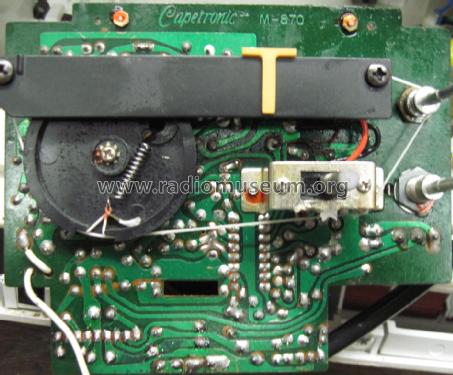
The design isn't like any Grundig I have seen. Quite a few other late 1970s early 1980s European / UK models do have two transistors and the TDA1220 but always wiith the TBA820 or similar. The SIL TA7xxx IC for the audio amp is more like in Far East designs, maybe a Toshiba chip? Did Grundig design it? It seems unlikely. It looks like a generic two transistor plus TDA1220 with the Toshiba style SIL audio amp added. Certainly Capetronic made it.
Michael Watterson, 22.Aug.18
Make sure it's unplugged from the mains supply. Remove kettle and teapot, then place upside down. Take out the four screws on the base plate.
Unplug the mains wires from the Radio on/off switch as they get in the way. Unplug the 6V - 0 - 6V AC supply and the audio out.
Removal of PCB.
Pull off the two knobs.
Unscrew the speaker retaining clip. It also hooks through a slot in the PCB.

Red Arrow.
Now examine the photo with arrows 1 to 3
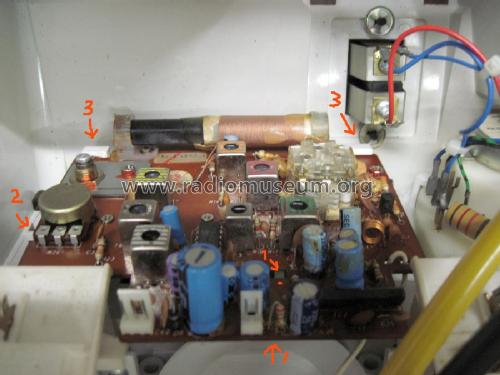
1 is the screw mount.
Clip (2) needs to be pushed back. Then the PCB is tilted up at front slightly and forward of the rear mounts (3).
Do NOT remove ANY screws on the PCB!
Do the reverse to refit, except the two plastic clips on front of the speaker need pushed with screwdriver to get speaker back into place before tightening the metal clip. Note it needs to hook through slot 1 on PCB.
Don't forget the two plugs on the PCB and the two wires to the radio on/off switch (mains and transformer).
Faults on my model
No audio at all. The switch on the mono 3.5" jack socket was high resistance. I unscrewed it, released top connection for tip of jack by pressing screwdriver into slot near the front. Cleaned and reassembled.
Still no audible sound, but very low level visible on the 'scope. The input had plenty of level on FM tuned to a local station. The output 220uF was where it was lost. It was only 10uF and 120 Ohms ESR. There was audible sound with a replacement fitted. Likely other capacitors have dried out as the audio level seems low.
The VHF-FM aerial is a trailing wire which had been cut and badly extended outside the case. I added a new length.
The switches for the kettle and tea pot may need cleaning as the those need jiggled to start it. The kettle has a sealed lid and uses the steam pressure to push water up the pipe from base of kettle to tea pot spout.
Michael Watterson, 22.Aug.18
